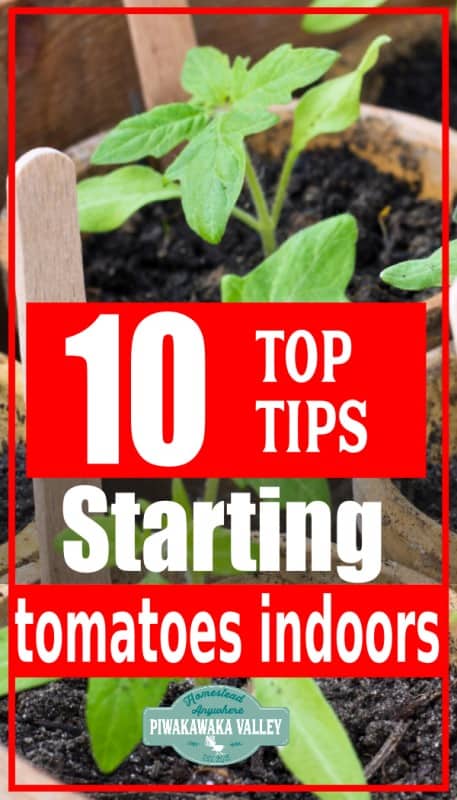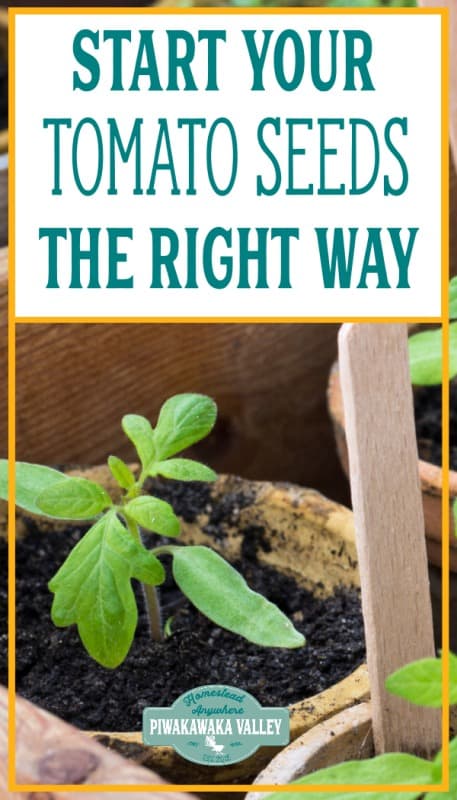This post was most recently updated on January 26th, 2021
It is the middle of Winter here and I am getting a lot of locals asking me how to start tomatoes indoors with a heat mat – or without a heat mat! Growing tomatoes at home is one of the best ways of improving your sustainability and if you can grow your tomatoes indoors you can extend your growing season significantly.
Please read: This information is provided for educational purposes only and is not intended to treat, diagnose or prevent any disease. We encourage you to make your own health care decisions in partnership with a qualified health care professional.
This post contains affiliate links, this means at no extra cost to you, we make a commission from sales. Please read our Disclosure Statement
How to start tomatoes indoors
There are some things that tomatoes need to get growing quickly and give you nutritious fruit. With the right soil, heat and light you will grow healthy tomato plants indoors or out.
There are many reasons you might need to start your tomato seeds inside – our summers are not as hot or as long as many places, so starting my tomatoes early in Winter ensures I have nice big plants to plant out when the weather warms up.
Soil for growing tomatoes
Tomatoes do not tolerate being too wet or too dry. When you are starting seedlings, you want the soil to remain consistently moist, but not sopping wet. Soil that is too wet will rot out the seeds or encourage blight ( fungal disease) in plants.
For starting tomato seeds you will need a light, fluffy, well draining soil-free seed starting mix. You can make your own with a combination of peat moss, leaf mold or compost, perlite and vermiculite, or you can buy a specially made mix – this is what I do!
Trays for sowing tomato seeds
You can re-use seed cell trays from other transplants that you have bought – or you can often pick up other peoples empty trays for free if you ask around.
Personally, I use 10×20 inch 50 cell trays and put them in a 10×20 flat that does not have holes in the bottom of it so that I can bottom water (see below) and I sow only 1 seed per cell as this saves pricking the plants out just after they sprout.
Seeds for growing tomatoes
The BEST thing about growing tomatoes from seed is the massive range of heirloom and heritage tomato varieties that you can grow. You are no longer limited to the commercially available varieties!
You can also learn to save your own tomato seeds.
Tomatoes are either determinant or indeterminant. Determinant tomatoes grow to a predetermined size and then set all their fruit over a 3 week period, they are also known as bush tomatoes. You do not prune determinant tomatoes and they are often either cherry tomatoes or paste/cooking tomatoes.
Indeterminate tomatoes are the classic tomato vine that will simply sprawl and continue to fruit and grow and take over until the frost kills it off. These are the ones that we traditionally prune to a single leader and encourage them to grow up a trellis. Find out how to prune for the best harvest here.
Temperature – how to use a heat mat to start tomato seeds
Tomatoes need 20-30C / 70-85F to germinate. The easiest way to do this is to use a garden heat mat or a heated propagation table.
A heat mat is best run with a thermostat so that you don’t cook your seedlings – like this one.
To use a heat mat, you simply place your seed tray full of seed raising mix and seeds on the top of the mat and if you have a thermostat, place it in the soil of one of your seed cells.
You must keep the seed raising heat mat dry, so use a 10×20 flat under your cell/plug tray. Turn on the heat mat and wait for the seeds to germinate.
Alternatives to a heat mat for starting seeds
If you don’t have a heat mat you can place your seeds in one of the following:
- On a sunny windowsill
- In your hot water cupboard
- On top of your fridge
- On the countertop in a nice warm kitchen or laundry
Once tomato plants have germinated they no longer need all the extra heat, in fact too much heat will cause them to grow long and leggy which makes them less strong. However, they do need to be kept away from frost, as a frost will destroy all your hard work and kill the plants.
RELATED: tomato plants growing tall and spindly?
RELATED: 10 top tips for growing tomatoes
Water for tomato seeds and seedlings
Tomatoes struggle if they are too wet – they succumb quickly to rot or blight. They will also die quickly if they are left to dry out.
I like to bottom water my seeds by placing them in a try without holes on the bottom and ensuring that the cell tray fits properly so that the cell bottoms are just sitting flat and evenly on the bottom of the bottom tray.
Then you can simply add about 5-10mm or 1/4-1/4 an inch of water in the bottom tray every couple of days and let the soil wick the moisture up to where it is needed.
Alternatively you can mist the soil to keep it moist. Avoid heavy watering from the top as you will displace the seeds.
Light for sprouting tomato seeds
Germinating seeds do not need light. However, once the seeds are sprouted they will need plenty of light. Ideally in a full sun position, or even better directly under some grow lights.
The brighter the light, the less leggy your plants will be.
Potting on tomato seedlings
Once your seedlings are about 15-20cm/6-8 inches tall they will be calling out for more space and more soil. If your frosts are all done by then, you can plant your plants straight in to where they will grow.
If you are needing to continue growing your tomato plants indoors for a little longer, it is time to pot them on to larger pots. This is when I use 10cm / 4inch pots filled with good quality tomato mix or at least potting mix.
Be sure to bury as much of the tomato as you can when you pot them on as they will grow more roots down the buried stem, giving you better, more fruitful plants in the long run. Just make sure the growing tips are at least sticking out above the top of the soil.
When should I start tomatoes indoors?
Usually you will start your tomatoes indoors 4-8 weeks before your last frost date. If you are wanting larger plants to plant out, you can sow your tomato seeds even earlier, as long as you can provide them with ample light and warmth to encourage early growth. Plants without adequate light and warmth will sit in stasis until the sun light hours are long enough for them to take off.
Do you have to start tomatoes indoors?
No, you can grow tomatoes directly outside if your season is long enough and warm enough for this. Tomatoes need consistent soil temperatures of over 20C/70F to germinate – for most places this means they will need to be inside at least until they germinate.
Should I soak tomato seeds before planting?
You can if you like, however I have not found any advantage to soaking tomato seeds before planting them. In fact, it is more annoying trying to sow wet seeds as they stick together in clumps. As long as your soil is moist when you sow the seeds and you keep it evenly moist your tomato seeds will do just fine without pre-soaking them.
Can you use egg cartons to start seeds?
Egg cartons, egg shells, toilet rolls and peat/coconut pellets all work brilliantly for starting tomato seeds if you cannot access cell trays, or if you are looking for more eco-friendly ways to start your seedlings.
How much light do tomatoes need indoors?
Tomatoes need at least 8 hours of direct light each day, the more light the plants get the better they will grow. If you don’t have a sunny spot that gets that amount of direct sun, tomatoes do respond well to grow lights, try and keep them no more than 10cm/4inches above the tops of the plants.
Be sure to get a full spectrum grow light, I like the adjustability of this design.
Can you grow tomatoes indoors all year round?
Yes! As long as they avoid the frost – keep the temperatures above 10C/50F overnight and ensure the plants are getting at least 8 hours of direct light each day and your tomatoes will continue to grow and produce all year long.
The only real limit to growing your tomatoes indoors all year is how tall you can stake your plants. Keep watering your tomatoes, and feed them each week with some liquid fertilizer, we alternate between a seaweed fertiliser and a blood meal mix to enjoy fresh tomatoes even in the middle of Winter!
If you are wanting to grow tomatoes this year from seed, these steps will help you germinate your seeds perfectly and grow the best indoor tomato plants.
If you would like help getting the most out of your garden, I would love to help you, find out more here
RELATED: Free Gardening Resources
If you like tips on frugal living, self sufficiency and consuming less, sign up to our newsletter below, I would LOVE to have you
For further reading, I really recommend all of these books. I own every one of them and they are amazing resources!































